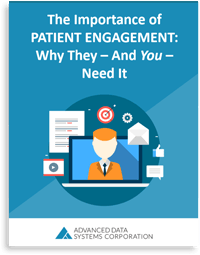Healthcare Blog
The latest in all things RCM, Electronic Health Records, Radiology Information Systems, Practice Management, Medical Billing, Value-Based Care, & Healthcare IT.
Christina Rosario
Christina Rosario is the Director of Sales and Marketing at Advanced Data Systems Corporation, a leading provider of healthcare IT solutions for medical practices and billing companies. When she's not helping ADS clients boost productivity and profitability, she can be found browsing travel websites, shopping in NYC, and spending time with her family.

By:
Christina Rosario
July 27th, 2017
When you first entered the medical profession, patients typically were asked to make reimbursements for treatment under a fee-for-service system. That is a natural aspect of providing healthcare in a capitalist country like the United States, where the focus can sometimes be on profits rather than on achieving the highest standards of care.

By:
Christina Rosario
July 18th, 2017
Does your medical organization currently provide care for Medicare or Medicaid patients, or are you planning to begin offering service to them in the near future? You should know that the government has a keen interest in streamlining how we deliver healthcare in the United States, with an emphasis on quality over quantity. To that end, the Centers for Medicare and Medicaid Services (also known as CMS) launched its Medicare and Medicare Electronic Health Record Incentive Programs in 2011 to encourage eligible providers to demonstrate Meaningful Use.

The Importance of Patient Engagement: Why They - And You - Need It
Learn why patient engagement is a necessity and how you can master it within your practice.

By:
Christina Rosario
June 13th, 2017
In any business, it will typically take a lot more time, effort and other resources to attract new customers than it does to retain them. The same typically holds true in healthcare organizations. Better patient engagement fosters trust between patients and the professionals treating them and is key for maintaining continuity of care. There are also financial considerations to keep in mind, of course, that will motivate practices to do their best to engage with each patient to keep them happy and satisfied with the services they receive.

By:
Christina Rosario
December 7th, 2016
We all have our own roles to play as we do our part to promote health in society. From the patient perspective, special attention to preventative care, nutrition, exercise, and getting vaccinations when recommended by a physician are examples of what ordinary people can do to cut down on the costs of healthcare in this country. From the perspective of medical practices, getting ready for MACRA and MIPS is an essential aspect of streamlining healthcare services and being more efficient in how we diagnose and treat each patient.

By:
Christina Rosario
October 28th, 2016
Inefficiencies in the way we provide medical services to patients in the United States have led to increasing costs while not necessarily leading to equivalent improvements in the outcomes of each sick and injured person being treated. Doctors and other medical professionals with an overriding goal to help others above all else may be dismayed when they consider how much emphasis is placed on finances rather than the healing arts.

By:
Christina Rosario
October 18th, 2016
Your medical organization routinely sees a large number of patients who are covered by Medicare or Medicaid. This may be attributed mostly to your location, such as near retirement facilities, senior care organizations and other entities charged with serving the elderly and other eligible patients. Or, the nature of your practice attracts more people who rely on government-funded medical coverage. Regardless of the reasons why you are treating more people under Medicare and Medicaid, you are also concerned that you are getting the appropriate financial incentives from the government. Under the American Recovery and Reinvestment Act of 2009, the government began offering Medicare and Medicaid incentives to medical professionals in exchange for them attesting to Meaningful Use.

Healthcare Advice | Value-Based Care
By:
Christina Rosario
September 29th, 2016
Recent headlines demonstrate some patients will experience yet another change in healthcare coverage in 2017. Aetna plans to sharply reduce their participation in the healthcare exchanges (dropping coverage in 75% of the states they cover now), leaving them only offering policies in four states when the new year rolls around. They are joining other major carriers like United Healthcare and Humana who say operating in some states creates onerous financial burdens they aren't willing to face going forward.

By:
Christina Rosario
September 27th, 2016
As winter approaches, savvy owners and managers of medical practices are already looking ahead to 2017 with an eye toward seeing what regulations, financial incentives, and other factors will affect their bottom line.

By:
Christina Rosario
August 29th, 2016
Big changes are coming to how we provide healthcare services in the United States. In a bid to improve efficiencies and treat more patients more quickly with less waste, we are going to be transitioning from the older model based on fees for services to a new one that is dedicated more to value-based reimbursements.

By:
Christina Rosario
August 24th, 2016
Anyone who has endured spending too much time in a crowded waiting room waiting for a doctor can appreciate the benefits of an early and much-missed aspect of our healthcare system: the humble house call. And if you’ve ever felt so sick that you would much more prefer having a doctor see you at home than endure spending even a minute in a waiting room with other coughing individuals, a house call would be ideal. It helps conserve your strength as well as keep you from infecting others in public.